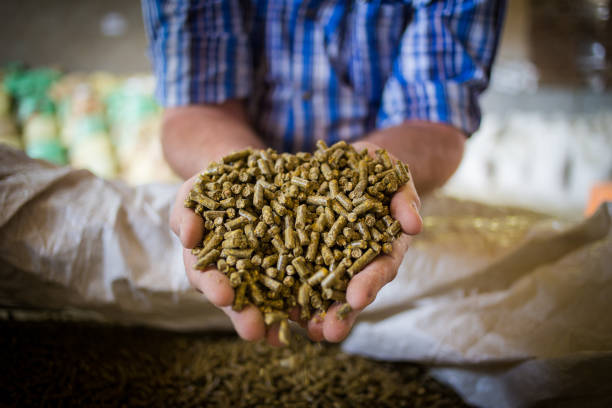The world of animal husbandry and agriculture is ever-evolving, and the quest for optimal animal nutrition remains a top priority. Precision pelletizing has emerged as a game-changer among the various techniques employed to improve feed efficiency. This innovative approach not only enhances feed digestibility but also significantly boosts animal performance.
In the Philippines, feed mill plants and equipment play a crucial role in this process. These facilities are equipped with state-of-the-art technology designed to streamline the production of high-quality pellets. These feed mill plants use precision pelletizing methods to ensure nutrients are efficiently delivered to livestock, maximizing growth rates and overall health.
Let’s delve into the intricacies of precision pelletizing and explore its far-reaching impacts on the livestock industry.
Understanding precision pelletizing
Precision pelletizing is an advanced feed manufacturing process that compresses and molds finely ground feed ingredients into dense, uniformly sized pellets. This technique goes beyond traditional pelletizing methods by incorporating cutting-edge technology and scientific principles to create a more easily digestible and nutritionally optimized animal feed.
Key components of precision pelletizing:
- Ingredient selection and preparation: Careful selection of high-quality raw materials and precise grinding to achieve optimal particle size.
- Conditioning: Precise control of moisture, temperature, and retention time during conditioning.
- Die selection: Use of specially designed dies with specific hole patterns and sizes to create pellets tailored to different animal species and life stages.
- Cooling and drying: Controlled cooling and drying processes to ensure pellet stability and durability.
- Quality control: Rigorous testing and monitoring throughout production to maintain consistency and quality.
The science behind enhanced digestibility
The precision pelletizing process significantly improves feed digestibility through several mechanisms:
1. Increased surface area
Grinding ingredients to a fine, uniform particle size before pelletizing increases the feed’s total surface area. This larger surface area allows for greater exposure to digestive enzymes in the animal’s gut, facilitating more efficient nutrient absorption.
2. Starch gelatinization
The controlled application of heat and moisture during the conditioning phase causes starch molecules to gelatinize. This process breaks down the complex starch structures, making them more accessible to digestive enzymes and increasing their overall digestibility.
3. Protein denaturation
Similar to starch gelatinization, the pelletizing process can partially denature proteins. This structural change can make proteins more susceptible to enzymatic breakdown in the animal’s digestive system, improving protein utilization.
4. Reduction of anti-nutritional factors
Some feed ingredients contain anti-nutritional factors that can impair nutrient absorption. The heat treatment involved in precision pelletizing can help neutralize or reduce these factors, further enhancing the feed’s nutritional value.
Impact on animal performance
The benefits of precision pelletizing extend far beyond improved digestibility. Let’s explore how this technique positively influences various aspects of animal performance:
1. Enhanced Feed Conversion Ratio (FCR)
Improved digestibility leads to a better feed conversion ratio. Animals can extract more nutrients from a smaller quantity of feed, leading to more efficient growth and production. This not only benefits the animals but also reduces feed costs for producers.
2. Consistent growth rates
Precision pelletized feed provides a uniform nutrient profile in every bite. This consistency ensures that animals receive balanced nutrition throughout their feeding period, promoting steady and predictable growth rates.
3. Reduced feed waste
The dense, uniform structure of precision pellets minimizes feed wastage. Unlike mash or poorly formed pellets, these high-quality pellets are less likely to crumble or be blown away, ensuring that more of the feed ends up in the animal rather than on the ground.
4. Improved gut health
The enhanced digestibility of precision pelletized feed can lead to better gut health. With more efficient nutrient absorption, there’s less undigested material in the gut, potentially reducing the risk of digestive disorders and promoting a healthier gut microbiome.
5. Increased palatability
The pelletizing process can enhance the taste and texture of the feed, making it more appealing to animals. Increased palatability often leads to improved feed intake, which is particularly beneficial for young or stressed animals.
Applications across different livestock sectors
Precision pelletizing has found applications across various livestock sectors, each with its unique benefits:
Poultry industry
Precision pelletized feed has been shown to significantly improve weight gain and feed efficiency in broiler production. It can also enhance egg production and shell quality in laying hens.
Swine production
Piglets and growing pigs benefit from increased digestibility, which shows improved growth rates and better feed conversion. Sows fed precision pelletized diets often exhibit better body condition and improved milk production.
Ruminant nutrition
While ruminants have complex digestive systems, precision pelletized concentrates can complement their forage-based diets, providing a consistent source of readily available nutrients. This is particularly beneficial in dairy production, where high nutrient demands must be met for optimal milk yield.
Aquaculture
In fish farming, precision pelletized feed has revolutionized nutrition management. The ability to create water-stable pellets with precise nutrient profiles has significantly improved growth rates and reduced water pollution from uneaten feed.
Environmental and economic implications
The adoption of precision pelletizing techniques extends beyond animal performance, offering significant environmental and economic benefits:
Reduced environmental footprint
By improving feed efficiency, precision pelletizing helps reduce the overall amount of feed required to produce animal products. This, in turn, leads to:
- Decreased land use for feed production
- Reduced water consumption
- Lower greenhouse gas emissions associated with feed production and animal digestion
Economic advantages
While the initial investment in precision pelletizing technology can be substantial, the long-term economic benefits are compelling:
- Lower feed costs due to improved feed conversion ratios
- Increased production efficiency leading to higher profits
- Potential premium pricing for higher quality animal products
Conclusion
Precision pelletizing represents a significant leap forward in animal nutrition and feed manufacturing. By enhancing feed digestibility and improving overall animal performance, this technique is reshaping the livestock industry. The benefits extend beyond the farm, contributing to more sustainable and economically viable animal production systems.
As we continue to face global challenges in food production and environmental sustainability, innovations like precision pelletizing will play a crucial role in meeting the growing demand for animal products while minimizing environmental impact. For livestock producers, nutritionists, and feed manufacturers, staying abreast of these advancements and incorporating them into their operations will be vital to remaining competitive in an ever-evolving industry.
The journey of precision pelletizing is far from over. As research progresses and technology advances, we can expect even more refined techniques and broader applications, further revolutionizing animal nutrition and sustainable livestock production.
Boost your livestock’s performance now! Embrace precision pelletizing for superior feed digestibility, and watch your animals thrive. Upgrade your feed, upgrade your results!

